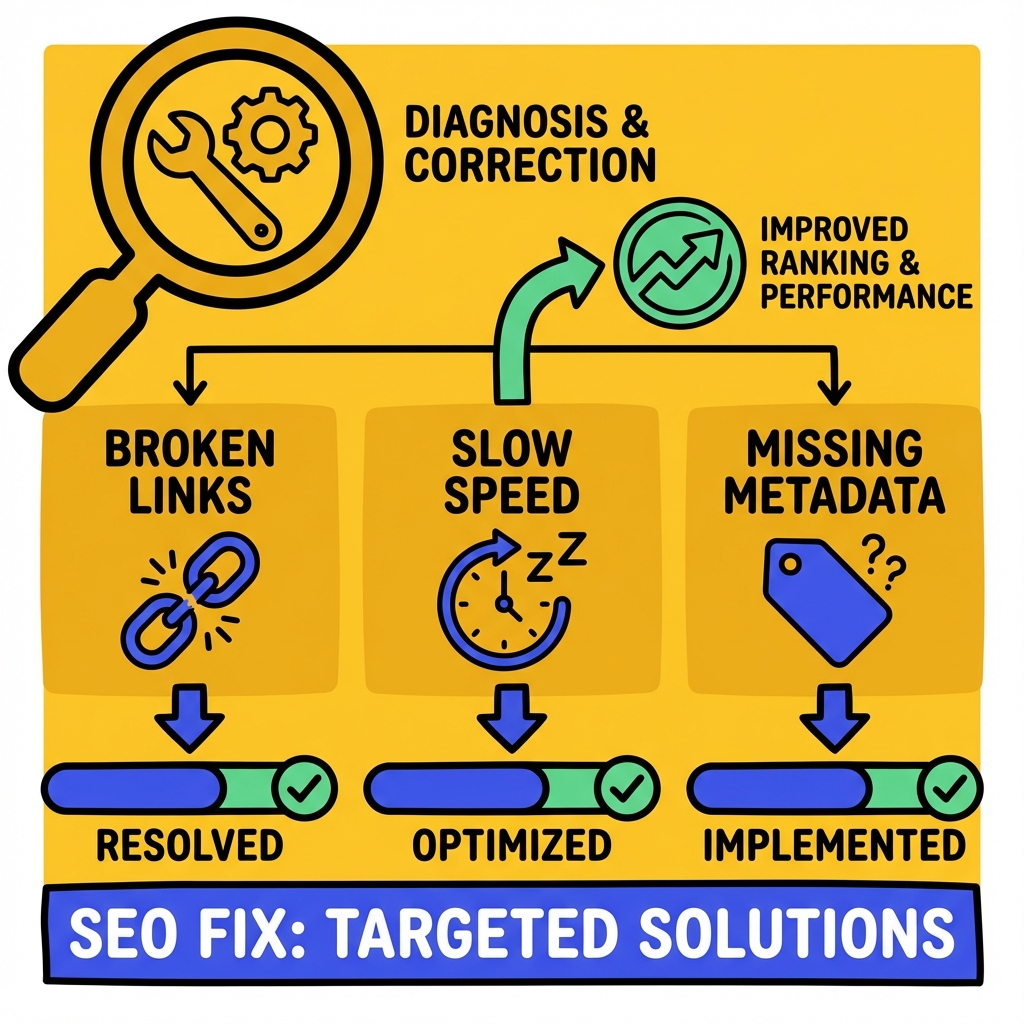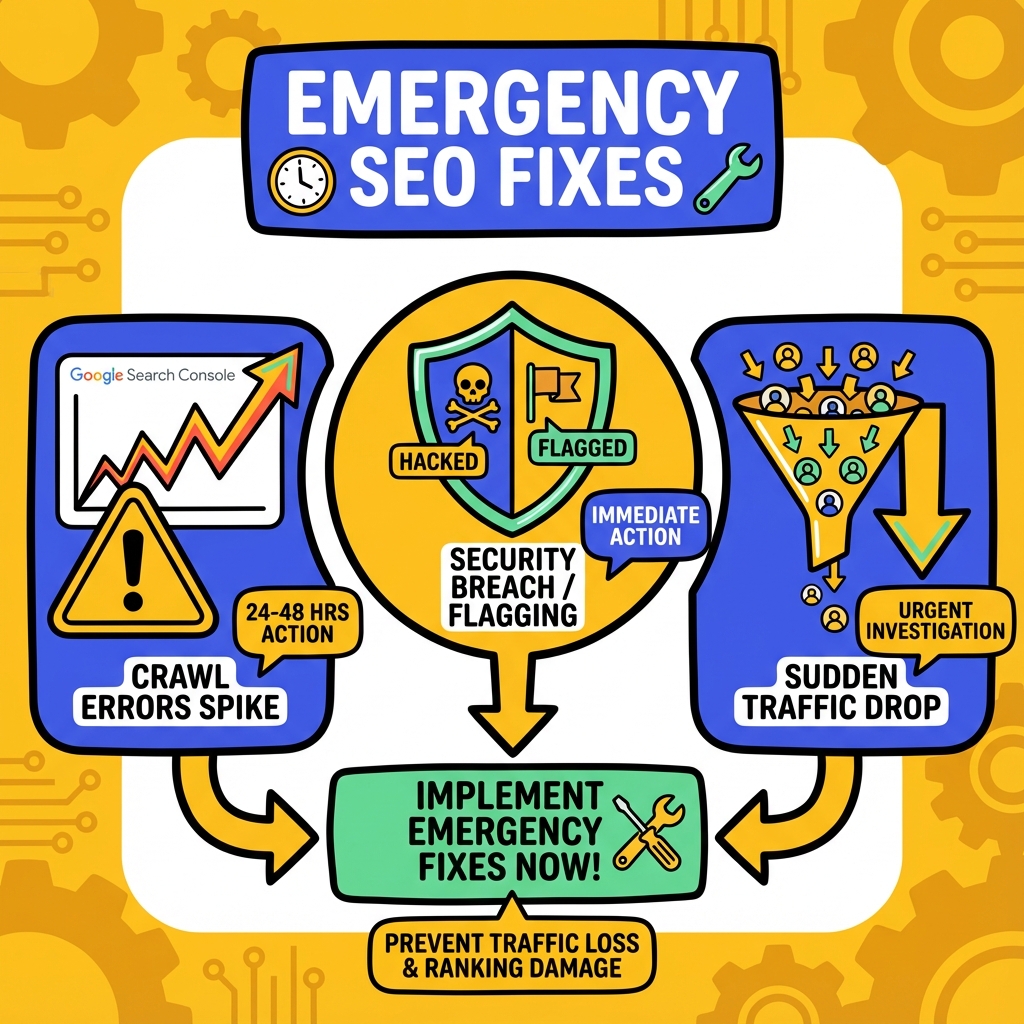What Exactly Constitutes an SEO Fix?
Posted by
How to Identify and Execute the Right SEO Fix for Your Website

When your website's search rankings suddenly drop or traffic starts declining, you need more than generic advice. You need a targeted SEO fix that addresses your specific problems. Understanding what constitutes an effective SEO fix and knowing when to implement one can mean the difference between a quick recovery and months of lost visibility. This comprehensive guide will walk you through identifying SEO issues, choosing the right solutions, and implementing fixes that deliver measurable results.
What Exactly Constitutes an SEO Fix?

An SEO fix is a targeted solution designed to resolve specific search engine optimization problems that prevent your website from ranking well or performing optimally in search results. Unlike broad SEO strategies, an SEO fix focuses on diagnosing and correcting particular issues that are actively harming your site's performance.
The most effective SEO fixes address root causes rather than symptoms. For example, if your pages are loading slowly, the fix isn't just optimizing images but identifying whether the problem stems from server issues, code bloat, or resource management. This targeted approach ensures that your efforts produce lasting improvements rather than temporary band-aids.
According to Google's Search Quality Evaluator Guidelines, search engines prioritize websites that provide excellent user experiences alongside quality content. An SEO fix should align with these core principles while addressing technical barriers that prevent search engines from properly crawling, indexing, and ranking your content.
How Do You Diagnose What SEO Fix Your Website Needs?
The diagnostic phase determines the success of any SEO fix implementation. Start by conducting a comprehensive technical audit using tools like Google Search Console, which provides direct insights into how Google perceives your website. Look for crawl errors, indexing issues, and mobile usability problems that could be impacting your rankings.
Performance metrics reveal critical areas requiring immediate attention. Analyze your page load speeds using Google PageSpeed Insights, check for broken internal and external links, and review your site's mobile responsiveness across different devices. These technical factors often require the most urgent SEO fixes because they directly impact user experience.
Content-related issues also demand specific fixes. Examine your pages for thin content, duplicate content problems, and missing or poorly optimized title tags and meta descriptions. Understanding keyword research fundamentals helps identify whether your content aligns with search intent and targets the right terms for your audience.
Common SEO Problems That Require Immediate Fixes
| Problem Type | Symptoms | Urgency Level |
|---|---|---|
| Technical Issues | Slow loading, 404 errors, crawl problems | High |
| Content Problems | Thin content, keyword stuffing, duplicates | Medium |
| User Experience | Poor mobile design, high bounce rates | High |
| Link Issues | Broken links, toxic backlinks | Medium |
What Steps Should You Follow for Technical SEO Fixes?

Technical SEO fixes form the foundation of website optimization and often deliver the most immediate results. Begin by addressing site speed issues, as page loading time directly impacts both user experience and search rankings. Optimize images by compressing file sizes without sacrificing quality, minify CSS and JavaScript files, and consider implementing a content delivery network for faster global loading times.
Mobile optimization represents another critical technical fix area. With mobile-first indexing, Google primarily uses the mobile version of your site for ranking purposes. Ensure your website displays correctly on all screen sizes, buttons are easily clickable, and text remains readable without zooming. Test your mobile experience regularly using Google's Mobile-Friendly Test tool.
Server and hosting issues can undermine even the best content strategies. Monitor your website's uptime, response times, and server errors through tools like Google Search Console. If you're experiencing frequent downtime or slow server responses, consider upgrading your hosting plan or switching to a more reliable provider that can support your traffic levels and performance requirements.
How Do You Execute Content-Based SEO Fixes?
Content fixes require a strategic approach that balances search engine requirements with user value. Start by identifying pages with thin or low-quality content that may be dragging down your overall site authority. Either substantially improve these pages by adding valuable information and insights, or consider removing them if they serve no meaningful purpose for your audience.
Duplicate content issues demand immediate attention because they confuse search engines about which version to rank. Use canonical tags to specify preferred versions of similar pages, rewrite duplicate content to make each page unique, or implement 301 redirects to consolidate multiple versions into a single authoritative page.
Optimizing existing content often produces faster results than creating entirely new pages. Review your top-performing content and identify opportunities to expand, update, or improve it. Creating high-quality blog posts that address user questions and provide comprehensive information can significantly boost your search visibility while supporting your overall content strategy.
Content Fix Priority Matrix
Focus your content improvement efforts using this priority framework:
High Impact, Low Effort: - Update meta titles and descriptions - Fix internal linking structure - Add alt text to images High Impact, High Effort: - Rewrite thin content pages - Create comprehensive topic clusters - Develop original research contentWhen Should You Implement Emergency SEO Fixes?

Certain situations require immediate SEO fixes to prevent significant traffic loss or ranking damage. If Google Search Console shows a sudden spike in crawl errors or indexing issues, address these problems within 24-48 hours. Similarly, if your website experiences a security breach or gets flagged for malware, implementing security fixes takes absolute priority.
Algorithm updates sometimes trigger the need for rapid SEO fixes. Monitor your rankings and traffic closely after major Google updates, and be prepared to adjust your strategy if you notice significant changes. However, avoid making hasty changes based on minor fluctuations, as rankings often stabilize within a few weeks of algorithm rollouts.
Manual penalties from Google require systematic fixes following their webmaster guidelines. If you receive a manual action notice, carefully review the specific issues mentioned, create a comprehensive fix plan, and document all changes before submitting a reconsideration request. According to Google's guidelines on manual actions, thorough documentation and genuine improvements are essential for penalty removal.
What Tools and Resources Support Effective SEO Fixes?
Professional SEO tools streamline the diagnostic and implementation process for most fixes. Google Search Console remains the most important free tool, providing direct insights from Google about your site's performance, errors, and improvement opportunities. Combine this with Google Analytics to understand how SEO fixes impact user behavior and conversion rates.
Technical audit tools like Screaming Frog SEO Spider help identify site-wide issues that require systematic fixes. These tools can crawl your entire website to find broken links, missing meta tags, duplicate content, and other technical problems that might not be immediately visible through manual inspection.
For content-related fixes, tools like SEMrush or Ahrefs provide keyword research capabilities and content gap analysis. However, understanding organic traffic patterns through your analytics data often reveals more actionable insights about which content fixes will deliver the greatest impact for your specific audience.
How Do You Measure SEO Fix Success?
Measuring the effectiveness of your SEO fixes requires establishing clear baselines before implementation and tracking relevant metrics over time. Document your current rankings, traffic levels, and technical performance scores before making changes, then monitor these same metrics weekly to assess improvement trends.
Different types of fixes show results at different speeds. Technical fixes like improving page speed or fixing crawl errors often show improvements within days or weeks. Content-related fixes typically take longer, with significant ranking improvements appearing over 1-3 months as search engines re-evaluate and re-index your updated content.
Set realistic expectations based on the scope of your fixes and your website's current authority level. Newer websites or those with limited domain authority may see more dramatic percentage improvements but still require consistent effort over time to achieve competitive rankings in their target markets.
Conclusion
Implementing the right SEO fix at the right time can transform your website's search performance and rescue declining traffic. Success depends on accurate diagnosis, strategic prioritization, and systematic execution of targeted solutions. Remember that effective SEO fixes address root causes rather than surface-level symptoms, ensuring lasting improvements that support long-term growth.
The key to successful SEO fixes lies in maintaining a data-driven approach while staying focused on user experience. Monitor your results consistently, document what works for your specific situation, and be prepared to adapt your strategy as search engines evolve and your audience's needs change.
Ready to identify and implement the SEO fixes your website needs? Start with a comprehensive audit of your current performance, prioritize the issues with the greatest potential impact, and take systematic action to address each problem area.